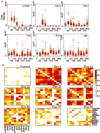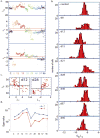Critical Points in Tumorigenesis: A Carcinogen-Initiated Phase Transition Analyzed via Single-Cell Proteomics
- PMID: 26780498
- PMCID: PMC4886749
- DOI: 10.1002/smll.201501178
Critical Points in Tumorigenesis: A Carcinogen-Initiated Phase Transition Analyzed via Single-Cell Proteomics
Abstract
A kinetic, single-cell proteomic study of chemically induced carcinogenesis is interpreted by treating the single-cell data as fluctuations of an open system transitioning between different steady states. In analogy to a first-order transition, phase coexistence and the loss of degrees of freedom are observed. The transition is detected well before the appearance of the traditional biomarker of the carcinogenic transformation.
Keywords: carcinogenesis; microfluidics; phase transition; single-cell proteomics; steady state.
© 2016 WILEY-VCH Verlag GmbH & Co. KGaA, Weinheim.
Figures



Similar articles
-
Single Cell Proteomics for Molecular Targets in Lung Cancer: High-Dimensional Data Acquisition and Analysis.Adv Exp Med Biol. 2018;1068:73-87. doi: 10.1007/978-981-13-0502-3_7. Adv Exp Med Biol. 2018. PMID: 29943297 Review.
-
AKT is critically involved in cooperation between obesity and the dietary carcinogen amino-1-methyl-6-phenylimidazo [4,5-b] (PhIP) toward colon carcinogenesis in rats.Biochem Biophys Res Commun. 2014 Jan 17;443(3):852-7. doi: 10.1016/j.bbrc.2013.12.059. Epub 2013 Dec 14. Biochem Biophys Res Commun. 2014. PMID: 24342614
-
Microfluidics-based single-cell functional proteomics for fundamental and applied biomedical applications.Annu Rev Anal Chem (Palo Alto Calif). 2014;7:275-95. doi: 10.1146/annurev-anchem-071213-020323. Epub 2014 Jun 2. Annu Rev Anal Chem (Palo Alto Calif). 2014. PMID: 24896308 Review.
-
Piroxicam and c-phycocyanin prevent colon carcinogenesis by inhibition of membrane fluidity and canonical Wnt/β-catenin signaling while up-regulating ligand dependent transcription factor PPARγ.Biomed Pharmacother. 2014 Jun;68(5):537-50. doi: 10.1016/j.biopha.2014.03.007. Epub 2014 Mar 19. Biomed Pharmacother. 2014. PMID: 24721324
-
Recent advances in microfluidics for single-cell functional proteomics.Lab Chip. 2023 Mar 28;23(7):1726-1751. doi: 10.1039/d2lc01096h. Lab Chip. 2023. PMID: 36811978 Review.
Cited by
-
Personalized disease signatures through information-theoretic compaction of big cancer data.Proc Natl Acad Sci U S A. 2018 Jul 24;115(30):7694-7699. doi: 10.1073/pnas.1804214115. Epub 2018 Jul 5. Proc Natl Acad Sci U S A. 2018. PMID: 29976841 Free PMC article.
-
Phenotypic heterogeneity and evolution of melanoma cells associated with targeted therapy resistance.PLoS Comput Biol. 2019 Jun 5;15(6):e1007034. doi: 10.1371/journal.pcbi.1007034. eCollection 2019 Jun. PLoS Comput Biol. 2019. PMID: 31166947 Free PMC article.
-
Unveil early-stage nanocytotoxicity by a label-free single cell pH nanoprobe.Analyst. 2020 Nov 9;145(22):7210-7224. doi: 10.1039/d0an01437k. Analyst. 2020. PMID: 32960188 Free PMC article.
-
Critical transition and reversion of tumorigenesis.Exp Mol Med. 2023 Apr;55(4):692-705. doi: 10.1038/s12276-023-00969-3. Epub 2023 Apr 3. Exp Mol Med. 2023. PMID: 37009794 Free PMC article. Review.
-
Drug-Induced Resistance and Phenotypic Switch in Triple-Negative Breast Cancer Can Be Controlled via Resolution and Targeting of Individualized Signaling Signatures.Cancers (Basel). 2021 Oct 6;13(19):5009. doi: 10.3390/cancers13195009. Cancers (Basel). 2021. PMID: 34638492 Free PMC article.
References
-
- Waddington CH. The strategy of the genes ; a discussion of some aspects of theoretical biology. London. 1957:ix, 262.
Publication types
MeSH terms
Substances
Grants and funding
LinkOut - more resources
Full Text Sources
Other Literature Sources

